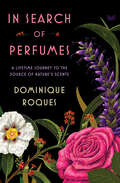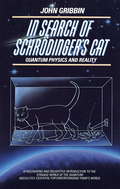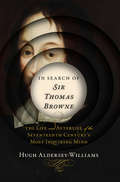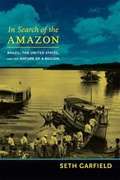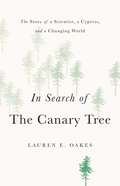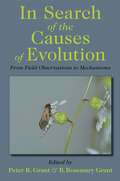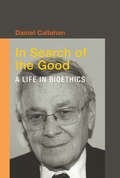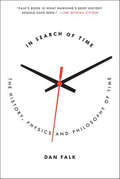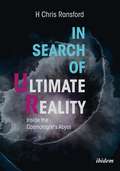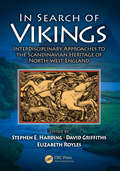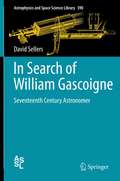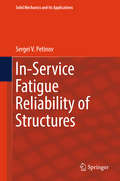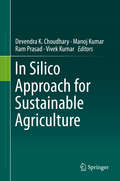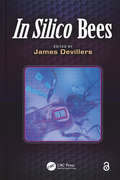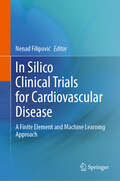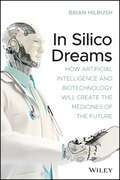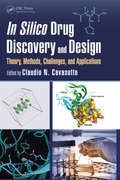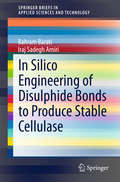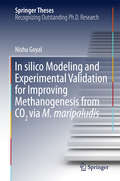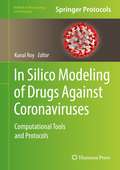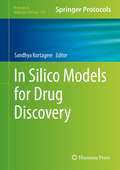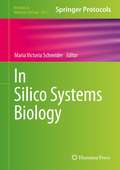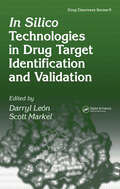- Table View
- List View
In Search of Perfumes: A Lifetime Journey to the Source of Nature's Scents
by Dominique Roques"[An] immersive debut... with detailed accounts of his trips and vivid descriptions of the scents ... [Roques'] rich travelogue will transport readers." – Publishers Weekly (Starred Review)In this intoxicating concoction of history, travelogue, and memoir, one of the perfume industry’s leading scouts of natural ingredients tells the story of the precious ingredients needed to make our favorite fragrances.Do you know how many flowers it takes to produce a kilo of rose oil? One million roses, each handpicked. When it comes to nature, Dominique Roques is a unique authority. He has spent the last thirty years working closely with local communities across the globe to establish a sustainable supply of natural ingredients crucial to perfume making.From resin cultivated by traditional methods in El Salvador to rose oil distilleries in India as old as the Taj Mahal, his network reveals an elusive trade built on the fault lines of tradition and modernity. With In Search of Perfumes, Roques tells the story of seventeen of the industry’s most precious ingredients–where they come from, their cultural and historic significance, and why we love them—from Indonesian patchouli to the "Damask rose,” interweaving his own recollections and reflections on his life and work.From Andalusia to Somaliland, Roques takes us on an exclusive tour of a vast but delicate ecosystem wholly sustained by the artisans who are its caretakers. Isolated and rural, the tropical jungles of northern Laos remain to this day the only source of benzoin that centuries earlier wafted through the air of Louis XIV’s court. In Madagascar, where every transaction is made in cash, a caravan of porters carry pallets bearing $500,000 dollars to exchange for vanilla beans. The Venezuelan tonka bean, as fickle as the weather, may refuse to flower for years but is so esteemed by perfumers that patience becomes its truest virtue. Everywhere Roques takes us, his infectious curiosity and amiability illuminate an immersive world of the uncharted.Entertaining and eye-opening, decorated with beautiful black-and-white illustrations, In Search of Perfumes is an irresistible exploration of the smells that fuel our nostalgia and suffuse our fantasies.Translated from the French by Stephanie SmeeSupplemental enhancement PDF accompanies the audiobook.
In Search of Schrodinger's Cat
by John GribbinQuantum theory is so shocking that Einstein could not bring himself to accept it. It is so important that it provides the fundamental underpinning of all modern sciences. Without it, we'd have no nuclear power or nuclear weapons, no TV, no computers, no science of molecular biology, no understanding of DNA, no genetic engineering. In Search of Schrodinger's Cat tells the complete story of quantum mechanics, a truth stranger than any fiction. John Gribbin takes us step by step into an ever more bizarre and fascinating place, requiring only that we approach it with an open mind. He introduces the scientists who developed quantum theory. He investigates the atom, radiation, time travel, the birth of the universe, superconductors and life itself. And in a world full of its own delights, mysteries and surprises, he searches for Schrodinger's Cat - a search for quantum reality - as he brings every reader to a clear understanding of the most important area of scientific study today - quantum physics. In Search of Schrodinger's Cat is a fascinating and delightful introduction to the strange world of the quantum - an essential element in understanding today's world.From the Trade Paperback edition.
In Search of Sir Thomas Browne: The Life and Afterlife of the Seventeenth Century's Most Inquiring Mind
by Hugh Aldersey-WilliamsThe extraordinary life and ideas of one of the greatest--and most neglected--minds in history. Sir Thomas Browne (1605-1682) was an English writer, physician, and philosopher whose work has inspired everyone from Ralph Waldo Emerson to Jorge Luis Borges, Virginia Woolf to Stephen Jay Gould. In an intellectual adventure like Sarah Bakewell's book about Montaigne, How to Live, Hugh Aldersey-Williams sets off not just to tell the story of Browne's life but to champion his skeptical nature and inquiring mind. Mixing botany, etymology, medicine, and literary history, Aldersey-Williams journeys in his hero's footsteps to introduce us to witches, zealots, natural wonders, and fabulous creatures of Browne's time and ours. We meet Browne the master prose stylist, responsible for introducing hundreds of words into English, including electricity, hallucination, and suicide. Aldersey-Williams reveals how Browne's preoccupations--how to disabuse the credulous of their foolish beliefs, what to make of order in nature, how to unite science and religion--are relevant today. In Search of Sir Thomas Browne is more than just a biography--it is a cabinet of wonders and an argument that Browne, standing at the very gates of modern science, remains an inquiring mind for our own time. As Stephen Greenblatt has written, Browne is "unnervingly one of our most adventurous contemporaries."
In Search of the Amazon: Brazil, the United States, and the Nature of a Region
by Seth GarfieldChronicling the dramatic history of the Brazilian Amazon during the Second World War, Seth Garfield provides fresh perspectives on contemporary environmental debates. His multifaceted analysis explains how the Amazon became the object of geopolitical rivalries, state planning, media coverage, popular fascination, and social conflict. In need of rubber, a vital war material, the United States spent millions of dollars to revive the Amazon's rubber trade. In the name of development and national security, Brazilian officials implemented public programs to engineer the hinterland's transformation. Migrants from Brazil's drought-stricken Northeast flocked to the Amazon in search of work. In defense of traditional ways of life, longtime Amazon residents sought to temper outside intervention. Garfield's environmental history offers an integrated analysis of the struggles among distinct social groups over resources and power in the Amazon, as well as the repercussions of those wartime conflicts in the decades to come.
In Search of the Canary Tree: The Story of a Scientist, a Cypress, and a Changing World
by Lauren E. OakesThe surprisingly hopeful story of one woman's search for resiliency in a warming worldSeveral years ago, ecologist Lauren E. Oakes set out from California for Alaska's old-growth forests to hunt for a dying tree: the yellow-cedar. With climate change as the culprit, the death of this species meant loss for many Alaskans. Oakes and her research team wanted to chronicle how plants and people could cope with their rapidly changing world. Amidst the standing dead, she discovered the resiliency of forgotten forests, flourishing again in the wake of destruction, and a diverse community of people who persevered to create new relationships with the emerging environment. Eloquent, insightful, and deeply heartening, In Search of the Canary Tree is a case for hope in a warming world.
In Search of the Causes of Evolution: From Field Observations to Mechanisms
by Peter R. Grant & B. Rosemary GrantEvolutionary biology has witnessed breathtaking advances in recent years. Some of its most exciting insights have come from the crossover of disciplines as varied as paleontology, molecular biology, ecology, and genetics. This book brings together many of today's pioneers in evolutionary biology to describe the latest advances and explain why a cross-disciplinary and integrated approach to research questions is so essential. Contributors discuss the origins of biological diversity, mechanisms of evolutionary change at the molecular and developmental levels, morphology and behavior, and the ecology of adaptive radiations and speciation. They highlight the mutual dependence of organisms and their environments, and reveal the different strategies today's researchers are using in the field and laboratory to explore this interdependence. Peter and Rosemary Grant--renowned for their influential work on Darwin's finches in the Galápagos--provide concise introductions to each section and identify the key questions future research needs to address. In addition to the editors, the contributors are Myra Awodey, Christopher N. Balakrishnan, Rowan D. H. Barrett, May R. Berenbaum, Paul M. Brakefield, Philip J. Currie, Scott V. Edwards, Douglas J. Emlen, Joshua B. Gross, Hopi E. Hoekstra, Richard Hudson, David Jablonski, David T. Johnston, Mathieu Joron, David Kingsley, Andrew H. Knoll, Mimi A. R. Koehl, June Y. Lee, Jonathan B. Losos, Isabel Santos Magalhaes, Albert B. Phillimore, Trevor Price, Dolph Schluter, Ole Seehausen, Clifford J. Tabin, John N. Thompson, and David B. Wake.
In Search of the Good: A Life in Bioethics (Basic Bioethics)
by Daniel CallahanOne of the founding fathers of bioethics describes the development of the field and his thinking on some of the crucial issues of our time. Daniel Callahan helped invent the field of bioethics more than forty years ago when he decided to use his training in philosophy to grapple with ethical problems in biology and medicine. Disenchanted with academic philosophy because of its analytical bent and distance from the concerns of real life, Callahan found the ethical issues raised by the rapid medical advances of the 1960s—which included the birth control pill, heart transplants, and new capacities to keep very sick people alive—to be philosophical questions with immediate real-world relevance. In this memoir, Callahan describes his part in the founding of bioethics and traces his thinking on critical issues including embryonic stem cell research, market-driven health care, and medical rationing. He identifies the major challenges facing bioethics today and ruminates on its future.Callahan writes about founding the Hastings Center—the first bioethics research institution—with the author and psychiatrist Willard Gaylin in 1969, and recounts the challenges of running a think tank while keeping up a prolific flow of influential books and articles. Editor of the famous liberal Catholic magazine Commonweal in the 1960s, Callahan describes his now-secular approach to issues of illness and mortality. He questions the idea of endless medical “progress” and interventionist end-of-life care that seems to blur the boundary between living and dying. It is the role of bioethics, he argues, to be a loyal dissenter in the onward march of medical progress. The most important challenge for bioethics now is to help rethink the very goals of medicine.
In Search of the True Universe
by Martin HarwitAstrophysicist and scholar Martin Harwit examines how our understanding of the cosmos advanced rapidly during the twentieth century and identifies the factors contributing to this progress. Astronomy, whose tools were largely imported from physics and engineering, benefited mid-century from the US policy of coupling basic research with practical national priorities. This strategy, initially developed for military and industrial purposes, provided astronomy with powerful tools yielding access - at virtually no cost - to radio, infrared, X-ray, and gamma-ray observations. Today, astronomers are investigating the new frontiers of dark matter and dark energy, critical to understanding the cosmos but of indeterminate socio-economic promise. Harwit addresses these current challenges in view of competing national priorities and proposes alternative new approaches in search of the true Universe. This is an engaging read for astrophysicists, policy makers, historians, and sociologists of science looking to learn and apply lessons from the past in gaining deeper cosmological insight.
In search of the ultimate building blocks
by Gerard 'T HooftFrom 1960 until 1990 theoretical physicists and experimentalists worked together to probe deeper and deeper into the basic structure of matter, moving closer to an understanding of the ultimate building blocks of the universe. Gerard 't Hooft was closely involved in many of the advances in modern theoretical physics that led to improved understanding of elementary particles, and this is a first-hand account of one of the most creative and exciting periods of discovery in the history of physics. Using language a layperson can understand, this narrative touches on many central topics and ideas, such as quarks and quantum physics; supergravity, superstrings and superconductivity; the Standard Model and grand unification; eleven-dimensional space time and black holes. This fascinating personal account of the past thirty years in one of the most dramatic areas in twentieth-century physics will be of interest to professional physicists and physics students, as well as the educated general reader with an interest in one of the most exciting scientific detective stories ever.
In Search of Time: The History, Physics, and Philosophy of Time
by Dan FalkTime surrounds us. It defines our experience of the world; it echoes through our every waking hour. Time is the very foundation of conscious experience. Yet as familiar as it is, time is also deeply mysterious. We cannot see, hear, smell, taste, or touch it. Yet we do feel it—or at least we think we feel it. No wonder poets, writers, philosophers, and scientists have grappled with time for centuries. In his latest book, award-winning science writer Dan Falk chronicles the story of how humans have come to understand time over the millennia, and by drawing from the latest research in physics, psychology, and other fields, Falk shows how that understanding continues to evolve. In Search of Time begins with our earliest ancestors' perception of time and the discoveries that led—with much effort—to the Gregorian calendar, atomic clocks, and "leap seconds." Falk examines the workings of memory, the brain's remarkable "bridge across time," and asks whether humans are unique in their ability to recall the past and imagine the future. He explores the possibility of time travel, and the paradoxes it seems to entail. Falk looks at the quest to comprehend the beginning of time and how time—and the universe—may end. Finally, he examines the puzzle of time's "flow," and the remarkable possibility that the passage of time may be an illusion.Entertaining, illuminating, and ultimately thought provoking, In Search of Time reveals what some of our most insightful thinkers have had to say about time, from Aristotle to Kant, from Newton to Einstein, and continuing with the brightest minds of today.
In Search of Ultimate Reality: Inside the Cosmologist’s Abyss
by H. Chris RansfordIs there such a thing as a fundamental reality, something which was around before our universe came into existence and which will still remain when all matter, time, and space itself ultimately disappear? Something fundamental which, in turn, can make space and time and matter arise from seemingly nothing? Under most cosmological and physical models, the last known remnants of reality are the disembodied laws of mathematics—beyond which it is extremely difficult to probe further.Using contemporary physics, narrated at popular science level, Chris Ransford shows why full nothingness—a nothingness within which even the disembodied laws of mathematics would not exist—cannot possibly exist, and what most likely underpins and enables reality. This leads the author to a few thoughts as to how such knowledge may be verified and then deployed to achieve a better alignment with reality.
In Search of Vikings: Interdisciplinary Approaches to the Scandinavian Heritage of North-West England
by David Griffiths Stephen E. Harding Elizabeth RoylesThis book presents a collection of papers from experts in a broad range of disciplines, including history, archaeology, genetics, and linguistics, to provide a detailed understanding of the Vikings in peace and in war. It focuses on one particularly exciting area of the Viking world, namely the north-west section of England, where they are known to have settled in large numbers. The 12 integrated studies in this book are designed to reinvigorate the search for Vikings in this crucial region and to provide must-reading for anyone interested in Viking history.
In Search of William Gascoigne
by David SellersWilliam Gascoigne (c.1612-44) was the inventor of the telescopic sight and micrometer (instruments crucial to the advance of astronomy). His name is now known to historians of science around the world. For some considerable time after his tragic death at the age of 32 in the English Civil War, however, it seemed as if his achievements would be consigned to oblivion. Most of his papers were lost and even the few that survived have largely disappeared. This is the story of how his work was rescued. Into this story is woven an account of the state of astronomy and optics during Gascoigne's lifetime, so that the reader can appreciate the significance of his discoveries.
In-Service Fatigue Reliability of Structures (Solid Mechanics and Its Applications #251)
by Sergei V. PetinovThis book provides readers with the latest know-how and tools needed to assess the in-service strength and reliability of welded structures. It addresses the two principal mechanisms of structural material deterioration, fatigue and corrosion, which affect the in-service behavior of structures. In this regard, the primary focus is on fatigue in connection with various structural failure scenarios. Realistic and typical examples of welded structures’ design and residual life assessment are used throughout the book in order to show readers the complexity of real-world assessments. The book offers a valuable resource for master’s students in mechanical and civil engineering, and for engineers whose work involves fatigue design and in-service inspections of welded structures.
In Silico Approach for Sustainable Agriculture
by Devendra K. Choudhary Manoj Kumar Ram Prasad Vivek KumarThis book explores the role of in silico deployment in connection with modulation techniques for improving sustainability and competitiveness in the agri-food sector; pharmacokinetics and molecular docking studies of plant-derived natural compounds; and their potential anti-neurodegenerative activity. It also investigates biochemical pathways for bacterial metabolite synthesis, fungal diversity and plant-fungi interaction in plant diseases, methods for predicting disease-resistant candidate genes in plants, and genes-to-metabolites and metabolites-to-genes approaches for predicting biosynthetic pathways in microbes for natural product discovery. The respective chapters elaborate on the use of in situ methods to study biochemical pathways for bacterial metabolite synthesis; tools for plant metabolites in defence; plant secondary metabolites in defence; plant growth metabolites; characterisation of plant metabolites; and identification of plant derived metabolites in the context of plant defence. The book offers an unprecedented resource, highlighting state-of-the-art research work that will greatly benefit researchers and students alike, not only in the field of agriculture but also in many disciplines in the life sciences and plant sciences.
In Silico Bees
by James DevillersBees are critically important for ecosystem function and biodiversity maintenance through their pollinating activity. This book provides a collection of computational methods to those primarily interested in the study of the ecology, ethology, and ecotoxicology of bees. It presents numerous case studies to enable readers to understand the appropriateness but also the limitations of models in theoretical and applied bee research. Written by an international team of experts, this book covers the main types of modeling approaches that can be used in terrestrial ecology and applied ecotoxicology.
In Silico Clinical Trials for Cardiovascular Disease: A Finite Element and Machine Learning Approach
by Nenad FilipovićThis book covers in silico clinical trials of cardiovascular disease using a finite element and machine learning approach. Part I describes the fundamentals as well as the latest developments in the field: finite element modeling, system biology modeling for drug optimization, artificial intelligence approach for medical image processing, as well as pharmacokinetic and AI modeling. Part II provides use cases to describe how in silico clinical trials of cardiovascular disease are applied to specific cardiovascular diseases: carotid artery plaque modeling, aorta stenosis modeling, stent biodegradation modeling, surrogate AI model for left ventricle modeling, and more.This book is geared toward upper-level undergraduate and graduate students as well as for researchers in the domains of bioengineering, biomechanics, biomedical engineering and medicine.
In Silico Dreams: How Artificial Intelligence and Biotechnology Will Create the Medicines of the Future
by Brian S. HilbushLearn how AI and data science are upending the worlds of biology and medicine In Silico Dreams: How Artificial Intelligence and Biotechnology Will Create the Medicines of the Future delivers an illuminating and fresh perspective on the convergence of two powerful technologies: AI and biotech. Accomplished genomics expert, executive, and author Brian Hilbush offers readers a brilliant exploration of the most current work of pioneering tech giants and biotechnology startups who have already started disrupting healthcare. The book provides an in-depth understanding of the sources of innovation that are driving the shift in the pharmaceutical industry away from serendipitous therapeutic discovery and toward engineered medicines and curative therapies. In this fascinating book, you'll discover: An overview of the rise of data science methods and the paradigm shift in biology that led to the in silico revolution An outline of the fundamental breakthroughs in AI and deep learning and their applications across medicine A compelling argument for the notion that AI and biotechnology tools will rapidly accelerate the development of therapeutics A summary of innovative breakthroughs in biotechnology with a focus on gene editing and cell reprogramming technologies for therapeutic development A guide to the startup landscape in AI in medicine, revealing where investments are poised to shape the innovation base for the pharmaceutical industry Perfect for anyone with an interest in scientific topics and technology, In Silico Dreams also belongs on the bookshelves of decision-makers in a wide range of industries, including healthcare, technology, venture capital, and government.
In Silico Drug Discovery and Design: Theory, Methods, Challenges, and Applications
by Claudio N. CavasottoIn Silico Drug Discovery and Design: Theory, Methods, Challenges, and Applications provides a comprehensive, unified, and in-depth overview of the current methodological strategies in computer-aided drug discovery and design. Its main aims are to introduce the theoretical framework and algorithms, discuss the range of validity, strengths and limita
In Silico Engineering of Disulphide Bonds to Produce Stable Cellulase
by Bahram Barati Iraj Sadegh AmiriThis Brief highlights different approaches used to create stable cellulase and its use in different fields. Cellulase is an industrial enzyme with a broad range of significant applications in biofuel production and cellulosic waste management. Cellulase 7a from Trichoderma reesei is the most efficient enzyme in the bio hydrolysis of cellulose. In order to improve its thermal stability, it can be engineered using a variety of approaches, such as hydrophobic interactions, aromatic interactions, hydrogen bonds, ion pairs and disulfide bridge creation.
In silico Modeling and Experimental Validation for Improving Methanogenesis from CO2 via M. maripaludis
by Nishu GoyalThis thesis explores the ability of M. maripaludis to capture and convert CO2 to methane in the presence of free nitrogen, and offers a consolidated review of the metabolic processes and applications of M. maripaludis. Further, it develops, validates and analyzes the first genome-scale metabolic model (iMM518) of M. maripaludis. Readers will discover, for the first time, the impact of nitrogen fixation on methane production. As such, the thesis will be of interest to researchers working on M. maripaludis, biofuels and bioenergy, systems biology modeling and its experimental validation, estimation of maintenance energy parameters, nitrogen fixing microbes, and bioremediation.
In Silico Modeling of Drugs Against Coronaviruses: Computational Tools and Protocols (Methods in Pharmacology and Toxicology)
by Kunal RoyThis essential volume explores a variety of tools and protocols of structure-based (homology modeling, molecular docking, molecular dynamics, protein-protein interaction network) and ligand-based (pharmacophore mapping, quantitative structure-activity relationships or QSARs) drug design for ranking and prioritization of candidate molecules in search of effective treatment strategy against coronaviruses. Beginning with an introductory section that discusses coronavirus interactions with humanity and COVID-19 in particular, the book then continues with sections on tools and methodologies, literature reports and case studies, as well as online tools and databases that can be used for computational anti-coronavirus drug research. Written for the Methods in Pharmacology and Toxicology series, chapters include the kind of practical detail and implementation advice that ensures high quality results in the lab. Comprehensive and timely, In Silico Modeling of Drugs Against Coronaviruses: Computational Tools and Protocols is an ideal reference for researchers working on the development of novel anti-coronavirus drugs for SARS-CoV-2 and for coronaviruses that will likely appear in the future.
In Silico Models for Drug Discovery
by Sandhya KortagereInfectious diseases caused by viruses, parasites, bacteria, and fungi are the number one cause of death worldwide. Although new technologies have improved diagnosis of infectious diseases, the efficacy of all known current anti-infective agents is threatened by the spread of drug-resistant forms of the pathogens. Hence, there remains an urgent need to develop anti-infective agents that target drug-resistant pathogens. In Silico Models for Drug Discovery presents a comprehensive look at the role in silico models play in understanding infectious diseases and in developing novel therapeutics to treat them. Written by leading experts in the field, chapters cover topics such as techniques to derive novel antimicrobial targets, methods of interpreting polypharmacology-based drug target networks, and molecular dynamics techniques used to compute binding energies of drugs to their target proteins, to name a few. Written in the successful Methods in Molecular BiologyTM series or in review article format, chapters include introductions to their respective topics, lists of the necessary materials and reagents, step-by-step, readily reproducible protocols, and notes on troubleshooting and avoiding known pitfalls. Authoritative and easily accessible, In Silico Models for Drug Discovery seeks to serve both professionals and novices involved in the study and treatment of infectious diseases.
In Silico Systems Biology
by Maria Victoria SchneiderSystems biology can now be considered an established and fundamental field in life sciences. It has moved from the identification of molecular 'parts lists' for living organisms towards synthesising information from different 'omics'-based approaches to generate and test new hypotheses about how biological systems work. In Silico Systems Biology: Methods and Protocols, expert researchers in the field detail a practical set of chapters based often on actual materials used and develop for face-to-face training with examples and case studies. Written in the highly successful Methods in Molecular Biology series format, chapters include introductions to their respective topics, step-by-step workflows, and key tips on troubleshooting and avoiding known pitfalls. Authoritative and practical, Silico Systems Biology: Methods and Protocols seeks to aid scientists in the further study of network biology and mathematical models of biological systems.
In Silico Technologies in Drug Target Identification and Validation (Drug Discovery Series)
by Darryl León Scott MarkelThe pharmaceutical industry relies on numerous well-designed experiments involving high-throughput techniques and in silico approaches to analyze potential drug targets. These in silico methods are often predictive, yielding faster and less expensive analyses than traditional in vivo or in vitro procedures. In Silico Technologies in Drug Target Ide
